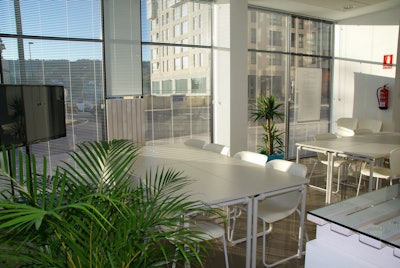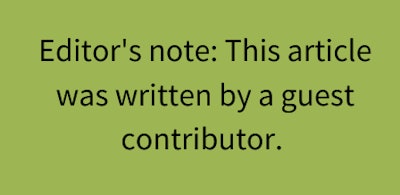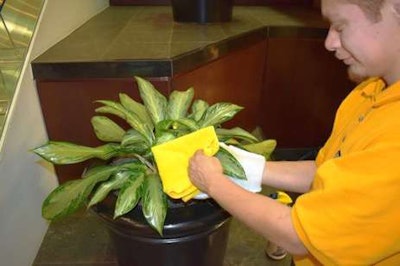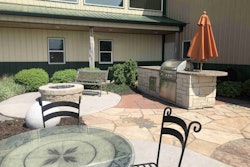
But an interior plantscaping contract is something most property managers and business owners probably haven’t encountered, unlike contracts for exterior landscape maintenance and snow removal. All of which are available from many commercial landscaping firms. Before getting a commercial client to put pen to paper, it’s a good idea to familiarize them with the various types of interior plantscaping contracts and the range of services they include. It’s also important to let them understand that not all contracts are created equal.
DIY or custom installation
The first thing they need to decide is whether their facility requires an interior plant installation designed by your company or if they can get by with existing plants. In some instances, a business may already have a complete indoor plant installation designed and installed by another company and is simply looking to replace the maintenance contract. Just remind them to be realistic if they’re trying to get by with the D.I.Y. approach to indoor plant design.
Employee interior plantscaping in the form of fossilized desk topiaries and over-grown hanging plants seldom presents a sharp image to either staff or clients. As commercial interior plantscaping firm, explain how you will listen to their requirements and present designs based on their budget and design goals. Providing computer renderings showing how the plants will look in the facility can help give them a clear idea of the final product prior to making a decision.
Keeping things green with a maintenance contract
Once you have created the perfect interior plantscaping installation for your client, they’re going to want to keep it looking green and healthy. This is where an interior plant maintenance contract is going to pay dividends for many months and even years to come. Clients can leave the watering and fertilizing to your company. There’s actually quite a bit more they can hand off and this is where it pays to make sure your customers understand what’s covered in a maintenance contract.
The first order of business is making the distinction between base services and optional services. Base services typically consist of weekly watering visits and basic plant maintenance including fertilizing, grooming, and plant replacement. Arrangements can be made to allow plant techs to access a water source on the premises or they can bring in a water supply in the form of rolling water canisters.
Depending on the nature of the business, they may want to have plant techs visit the property during off-hours. Many restaurants like to have plant maintenance staff comes in during the morning hours prior to the lunch rush. This may not be an issue for a business in an office setting where a plant tech can quietly go about the business of watering and tending to plant installations without causing much distraction to staff and customers. Nevertheless, it’s important to make sure that visit times are called out in the contract so maintenance visits don’t catch your customer by surprise.
Wait, there’s more!
Office plant maintenance services go well beyond simply tipping a watering can over the plants once a week. Plants require regular grooming in the way of removal of dead leaves and small branches that fall into pots or the bedding of a planter. It’s also not uncommon for man-made debris in the form of trash or other detritus tossed off by customers and staff to find its way into indoor plant installations. Clients will certainly want such debris discreetly removed and disposed of during planned maintenance visits.
Some plants aren’t as hardy as their counterparts and will require replacement. Make sure the replacement of under-performing plants is clearly mentioned in the maintenance contract. The cost should be covered by the monthly fee. Exceptions might be for damage caused by the client in the case of more expensive plants, but this should be clearly stated in the terms of the contract. The good news is that plant replacement is typically a straightforward process especially in planters containing multiple plants.
A well-designed interior plantscape will accommodate individual potted plants made to look like they have been “planted” into the soil of the planter. In reality, they are anchored in place with foam board which is then covered with a bedding material to conceal the pots. It’s then a simple matter of removing an individual plant – pot and all – and replacing it with a new one. Bedding material is then added back over the new plant to create a seamless appearance. A quick and easy process with little to no mess on the flooring.
Is leaf shining a thing?

But you can go one step further and have your interior plant maintenance crew shine the leaves of certain plants in the installation. An application of horticultural oil, typically neem oil, is applied to leave surfaces and buffed to a high luster. This is particularly desirable in brightly-lit locations such as atriums or in high-traffic retail locations.
It will definitely attract notice and help make that highly desirable great first impression.
In addition, neem oil can help keep pests such as spider mites and aphids at bay. Leave shining may either be included in the base services of a contract or offered as an option. If the installation includes broad-leaved plants be sure to mention leaf shining if your customer hasn’t requested it. It’s an additional touch they may want to consider.
Color and bloom rotations
Not typically a standard service, color and bloom rotations can add a refreshing dash of variety to the interior plantscaping installation. Plants typically on rotation schedules are flowering varieties included to add color. The most popular varieties are bromeliads and orchids. These plants are maintained by interior plant services firms for shorter periods than other varieties. An interior plantscaping contract will specify an optimal replacement schedule to ensure plants continue to look fresh and vibrant.
To provide an exotic and upscale look to a reception area, hotel suite, or spa, orchids are great candidates to add to a color rotation. The moth orchid’s graceful stems and delicate flowers have traditionally symbolized luxury and beauty. White, pink and lavender are the most common varieties, but a wide range of novelty colors are also available.
The final touch is human
Everything can be perfect from a stunning design to first-class installation and contract terms that align perfectly with your client’s budget. But it all can be undone if the customer has a disappointing experience with the maintenance staff. In the end, customer interactions with your company will primarily be with plant techs, so it’s vital that you can guarantee a level of professionalism from your staff.
When dealing with commercial clients, they generally expect all staff entering their facility to be uniformed, professional in conduct and appearance, and to respect their protocols concerning security and procedure. They should feel comfortable addressing any concerns that may arise with maintenance staff with the account manager and expect a prompt and courteous resolution to any issues. Your recourse for addressing issues with plant maintenance staff should be discussed during contract negotiations.
A satisfying experience with plant maintenance staff is a two-way street. Ensuring customers will uphold their end of the bargain in accommodating plant techs in the execution of their duties is essential to a successful arrangement. They should assist your staff with access to areas where plants are located and also to water sources if required will allow you to deliver the best possible service to their facility.
EDITOR’S NOTE: This article is authored by a regular blogger and writer Jason Phillips. He loves to decorate his home and office in new and different ways. He works for a site offering landscaping services. Also, he keeps sharing his ideas and the latest trends in interior designing through his articles.










